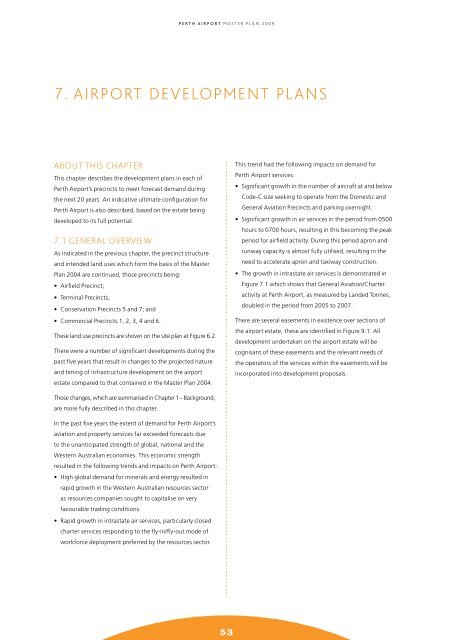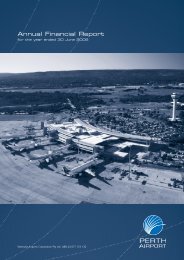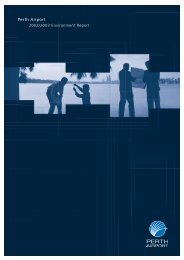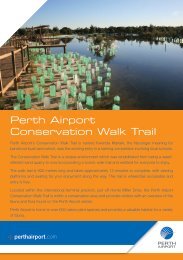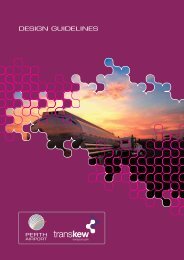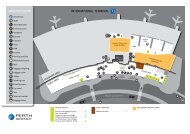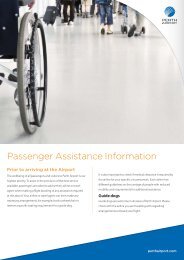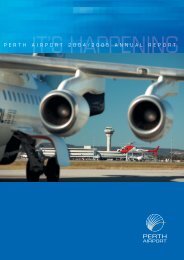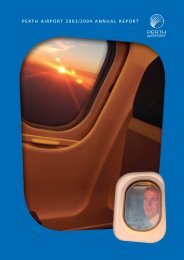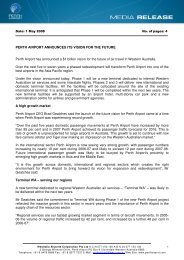PERTH AIRPORT Master Plan 2009
PERTH AIRPORT Master Plan 2009
PERTH AIRPORT Master Plan 2009
Create successful ePaper yourself
Turn your PDF publications into a flip-book with our unique Google optimized e-Paper software.
P E R T H A I R P O R T M a s t e r P l a n 2 0 0 9<br />
7. Airport development plans<br />
About this Chapter<br />
This chapter describes the development plans in each of<br />
Perth Airport’s precincts to meet forecast demand during<br />
the next 20 years. An indicative ultimate configuration for<br />
Perth Airport is also described, based on the estate being<br />
developed to its full potential.<br />
7.1 General Overview<br />
As indicated in the previous chapter, the precinct structure<br />
and intended land uses which form the basis of the <strong>Master</strong><br />
<strong>Plan</strong> 2004 are continued, those precincts being:<br />
• Airfield Precinct;<br />
• Terminal Precincts;<br />
• Conservation Precincts 5 and 7; and<br />
• Commercial Precincts 1, 2, 3, 4 and 6.<br />
These land use precincts are shown on the site plan at Figure 6.2.<br />
There were a number of significant developments during the<br />
past five years that result in changes to the projected nature<br />
and timing of infrastructure development on the airport<br />
estate compared to that contained in the <strong>Master</strong> <strong>Plan</strong> 2004.<br />
This trend had the following impacts on demand for<br />
Perth Airport services:<br />
• Significant growth in the number of aircraft at and below<br />
Code-C size seeking to operate from the Domestic and<br />
General Aviation Precincts and parking overnight.<br />
• Significant growth in air services in the period from 0500<br />
hours to 0700 hours, resulting in this becoming the peak<br />
period for airfield activity. During this period apron and<br />
runway capacity is almost fully utilised, resulting in the<br />
need to accelerate apron and taxiway construction.<br />
• The growth in intrastate air services is demonstrated in<br />
Figure 7.1 which shows that General Aviation/Charter<br />
activity at Perth Airport, as measured by Landed Tonnes,<br />
doubled in the period from 2005 to 2007.<br />
There are several easements in existence over sections of<br />
the airport estate, these are identified in Figure 9.1. All<br />
development undertaken on the airport estate will be<br />
cognisant of these easements and the relevant needs of<br />
the operators of the services within the easements will be<br />
incorporated into development proposals.<br />
Those changes, which are summarised in Chapter 1 – Background,<br />
are more fully described in this chapter.<br />
In the past five years the extent of demand for Perth Airport’s<br />
aviation and property services far exceeded forecasts due<br />
to the unanticipated strength of global, national and the<br />
Western Australian economies. This economic strength<br />
resulted in the following trends and impacts on Perth Airport:<br />
• High global demand for minerals and energy resulted in<br />
rapid growth in the Western Australian resources sector<br />
as resources companies sought to capitalise on very<br />
favourable trading conditions.<br />
• Rapid growth in intrastate air services, particularly closed<br />
charter services responding to the fly-in/fly-out mode of<br />
workforce deployment preferred by the resources sector.<br />
53


